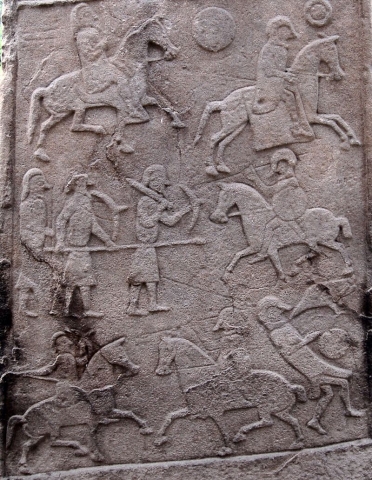The great Celtic Pictish victory over the Anglo-Saxon Kingdom of Northumbria at the Battle of Dun Nechtain

Northumbria was one of the most important kingdoms of Anglo-Saxon England, lying north of the River Humber. The name derives from the Old English Norþan-hymbre meaning "the people or province north of the Humber". The dates for the Kingdom of Northumbria are often given as 654-954 AD, although others give an earlier date for its founding of 547. This Kingdom experienced a period of significant expansion, including into the Celtic lands of the Picts and Gaels in present day Scotland.
This Northumbria threat was emphasised by the victory at the Battle of Degsastan, fought around 603 between king Æthelfrith of Bernicia and the Gaels under Áedán mac Gabráin, king of the Gaelic kingdom Dál Riada. This victory saw a period of Northumbrian expansion. Between 657 AD and 685 AD they occupied the southern lands of the Picts. However, this rise in the fortunes of Northumbria was curtailed by the emergence of Bridei, who was the son of King Neithon of Strathclyde.
King Bridei Mac Bili led a force of Picts which engaged in battle with the Northumbrians under King Ecgfrith on 20th May 685 AD at the Battle of Dun Nechtain also known as the Battle of Nechtansmere. With a series of brilliant manoeuvres they defeated the Northumbrians, killing King Ecgfrith in the process. Saint Bede (672/3 – 26 May 735) gives a brief account of the battle in his 8th-century work Historia ecclesiastica gentis Anglorum (The Ecclesiastical History of the English People). Additional detail is given in the Irish annals of Ulster and Tigernach. Further battles between the Northumbrians and Picts took place, however, it was the Battle of Dun Nechtain that marked the point in which the Picts freed themselves from the Northumbrian threat.
The Pictish language and culture has been the subject of much renewed interest over recent years. Their beautiful artwork and carving can be found throughout the north and east of Scotland. However, it always has to be remembered that the Pictish people and their descendants did not disappear. They were crucial in forging the kingdom Scotland. This newly formed kingdom of Scotland drove the Northumbrian boundary back to the River Tweed. There then followed a continued period of decline for Northumbria until their eventual merger into the rising kingdom of England.
Image: Pictish Stone at Aberlemno Church Yard said to detail the Battle of Nechtansmere.






